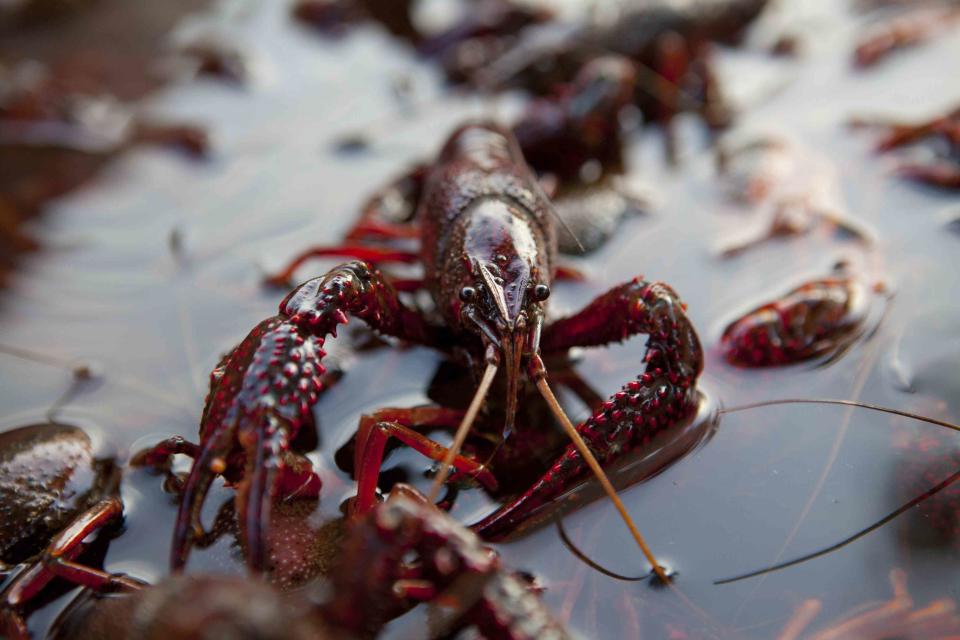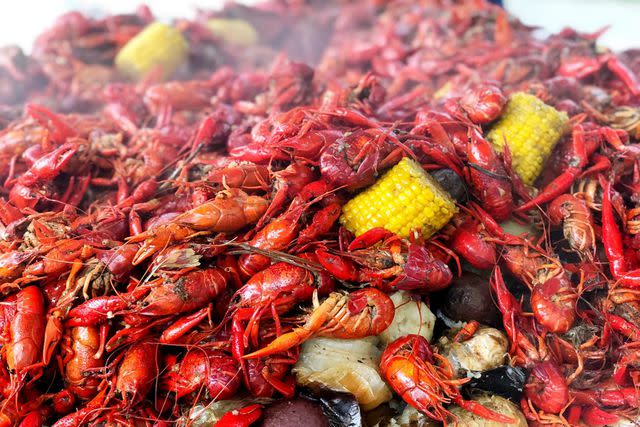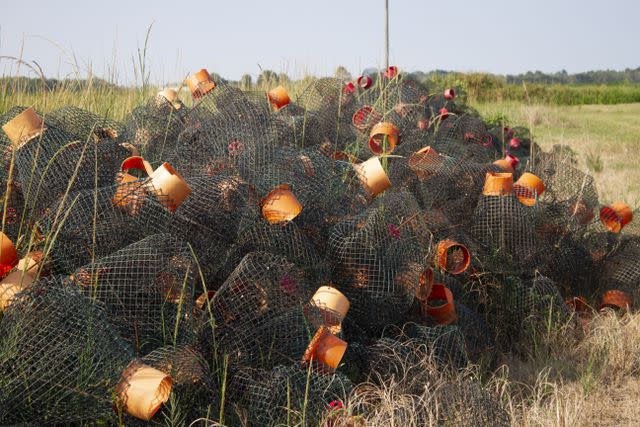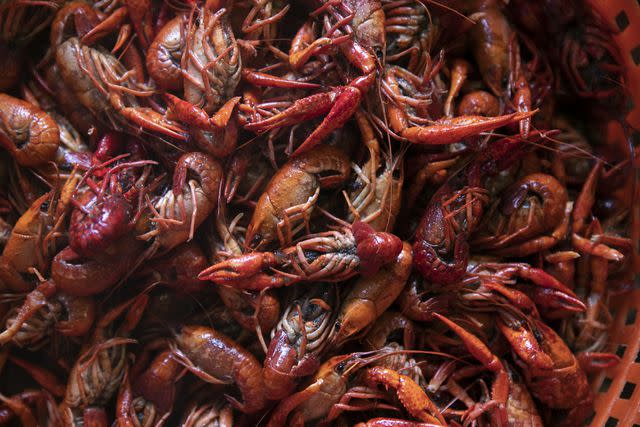In Louisiana, a Crawfish Shortage Is Threatening a Way of Life
Skyrocketing prices are forcing Louisianians to pay up — or go without.

Philip Gould / Getty Images
“Crawfish aren’t just essential to my restaurant, they’re central to our culture here in south Louisiana,” explained Jason Seither, owner of Seither’s Seafood in Harahan, Louisiana, just outside of New Orleans. “And when crawfish prices get as high as they got this season, it threatens an entire way of life.”
On any given year, these two-clawed, ten-legged red crustaceans — reminiscent of a lobster but much smaller at only three to six inches long — dominate springtime social gatherings and the menus of casual restaurants across Louisiana and beyond. And according to the office of Louisiana Governor Jeff Landry, as much as 200 million pounds of crawfish are farmed or caught in the state each year, contributing an incredible $500 million to the state’s annual economy. The vast majority of that crawfish is brought to market and consumed in the months of March, April, and May.
“You start to see crawfish during parties around the Mardi Gras season in February,” Seither said. “I’m just one small restaurant and we typically sell thousands of pounds of crawfish each day during the season. But this year has obviously been different.”
Related: How to Throw a Louisiana Crawfish Boil (Even If You're Landlocked)
In large part due to last year’s dangerously hot temperatures and the state’s worst drought on record, Louisiana’s early crawfish yield was severely affected. Field agents from the Louisiana State University Agricultural Center (LSU AgCenter) have worried that 75–90% of Louisiana’s farm-raised crawfish could be lost this year.
“And this doesn’t just mean people don’t get to enjoy their crawfish boils this year,” said David McCelvey, owner of Frankie & Johnny’s, a New Orleans restaurant that has long been known for its crawfish. “Restaurants like mine rely on crawfish sales to make up for slower times of the year. How do you survive after losing a month of your best sales? It’s not easy.”
Skyrocketing prices
The Louisiana Crawfish Promotion and Research Board says 7,000 Louisianians work directly or indirectly in the crawfish industry.
A $140 million loss has been estimated so far this season, meaning the entire industry has felt the effects as an unprecedented dearth of crawfish has caused prices to increase early in the season.
Related: How to Eat Crawfish
“Some places started selling boiled crawfish at more than $16 per pound,” McCelvey said, compared to prices closer to $5 per pound in recent years. “My customers wouldn’t go for that so we just kept them off the menu, hoping prices would come down as the season progressed.”

Carolyn Broussard / Getty Images
David McCelvey, owner of Frankie & Johnny’s in New Orleans, kept crawfish off the menu, stating that his customers wouldn’t go for the jacked-up price of $16 per pound.The mudbug shortage — and resulting skyrocketing of prices — is a complicated confluence of several factors. Chief among them, however, is a historic drought, which is believed to have killed crawfish across the state.
The rain never came
“I’ve lived in Louisiana my whole life, for 44 years,” said Christopher Bonvillain, associate professor in the department of biological sciences, with a specialty in crawfish, at Nicholls State University in Thibodaux, Louisiana. “And I’ve never seen a drought like what we experienced last summer. Here in hurricane-prone southeast Louisiana, a lack of water isn’t a problem we typically face, but even my older colleagues say this was an unprecedented problem.”
The majority of Louisiana’s mudbug supply comes from crawfish farming. A farmer will usually rotate their farms between use as a rice field one year, and then a crawfish pond the next.
Related: Great Recipes from Top New Orleans Chefs
During the rice field part of the cycle, when the fields are flooded and the rice has grown to a large enough size, the field is stocked with young crawfish. This typically takes place between April and June — approximately 10 months to a year before those crawfish will find their way to consumers.
The rice fields are then drained two to three weeks before the rice is harvested, which usually begins between late July and September.
“At this point, those crawfish will move to the perimeter of the field and burrow into the wet — but not flooded — soil, where they spawn,” explained Todd Fontenot, a field agent specializing in crawfish with the LSU AgCenter. “In a normal year, summer and autumn rains keep the burrows moist enough so the mothers and their babies can survive until it’s time to emerge and return to a reflooded rice-field-turned-crawfish-pond.”
But, last year, those rains never came. As a result, the burrows cracked and dried out. The ground was too hard for the crawfish to dig through, meaning they were stuck. Mothers either starved to death or ate their young, and many eventually suffocated anyway when their gills dried.
A confluence of forces
“When rain finally fell in late December and January, months too late, there were less crawfish than usual, and those crawfish hadn’t had a chance to grow yet,” Fontenot said. Persistent cold weather in January, uncommon for Louisiana, further slowed their growth. According to Fontenot, by the time the public wanted crawfish for Mardi Gras and into March, there just wasn’t much available — certainly not of a usable size. Naturally, the price skyrocketed.
But a lack of supply wasn’t the only reason for rising prices.
The popularity of crawfish also seems to be rising dramatically, within Louisiana, but also in new markets across the country. This has put additional strain on the limited supply.
Related: What to Do — and What Not to Do — at Your First Crawfish Boil
“We ship three million pounds of live crawfish out of the state each year to nearly every state that allows it,” said Justin Smith, owner of Louisiana Crawfish Company, which distributes crawfish in addition to running its own crawfish farm in Natchitoches, Louisiana. “A decade ago, that number was only about one million pounds. So interest in crawfish outside of Louisiana is growing fast.”

Bonnie Marquette / 500px / Getty Images
A record-breaking heat wave and the worst drought the state has ever seen have severely affected the season's crawfish harvest, causing an estimated $140 million loss.Additionally, cheap foreign crawfish from Asia are flooding the Louisiana and broader American market. Critics of imported crawfish, like the state’s Lieutenant Governor Billy Nungesser, say the competition is unfair for businesses, as well as unhealthy for consumers.
“This imported crawfish is raised in horrible conditions,” Nungesser said. “They’re sitting in human waste, and then chock full of antibiotics to help kill the bacteria. You eat those antibiotic-filled mudbugs and then develop a tolerance for it so the medicine can’t help you when you’re actually sick.”
Related: Our Favorite Places to Eat, Sleep, and Explore in New Orleans
Because foreign crawfish producers aren’t held to the same health standards as their Louisiana counterparts, Nungesser says they can raise their product for much cheaper, and then undercut local producers by selling their crawfish for less.
“On top of all that, they ship them here and then label them as Louisiana crawfish so consumers don’t even know what they’re actually buying — they just think they found a great deal, especially when crawfish prices are otherwise higher than past years.”
Looking to the future
As the season continues, much of the surviving crawfish that were slow to grow due to weather issues are finally reaching maturity and being harvested. This is driving the price of crawfish down — not quite to the level of previous years, but to prices customers are willing to pay.
“The higher prices we’re still seeing now might be because of inflation,” said Seither of Seither’s Seafood. “I mean, everything costs more these days, right?”
Related: Our 21 Favorite Cajun and Creole Recipes
Scientists, producers, and restaurateurs are all hopeful the droughts of last year were a one-off disaster. But many worry that as climate-related disasters become more frequent, this crawfish season might be the harbinger of a new normal.
“Climate issues are becoming more common, not less,” said Bonvillain, the associate professor at Nicholls State University. “Some people think farmers can just manually add water to help the crawfish survive, but that’s expensive, and also droughts result in higher salinity in much of the state’s water. That will kill the crawfish, too.”

sandoclr / Getty Images
Experts warn that the devastation to the crawfish population this year will mean the knock-off effect of a smaller supply next year.Bonvillain says the state of Louisiana dedicates more acreage to crawfish production each year. That, plus the industry’s efforts to learn the lessons of better drought management and the state’s commitment to eliminating unfair competition from imports, is all that can be done at the moment.
Some experts warn that the devastation to the crawfish population this year will mean the knock-off effect of a smaller supply next year, too, as there will be less mature crawfish to spawn a new generation.
Related: Crawfish Étouffée
For restaurateurs like Seither’s, the industry’s ability to find solutions could mean the difference between thriving and dying in a challenging but important industry. “In Louisiana, food is how we gather and how we celebrate. When I was a little kid, my dad and my uncle would host family and neighbors for these big Friday night crawfish boils,” he said. “I watched them build community and make people happy through food.”
“That's why I wanted to own a restaurant,” he added. “To do the same thing. We have grandparents and grandkids all at the same table, listening to live local music, and peeling their crawfish. It’s our tradition down here.”
For more Food & Wine news, make sure to sign up for our newsletter!
Read the original article on Food & Wine.

